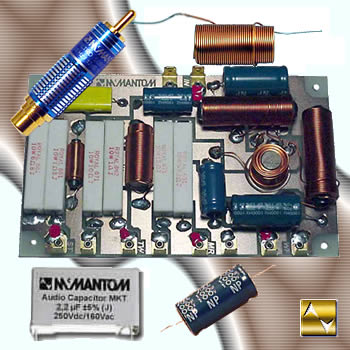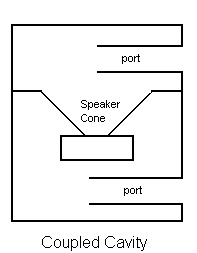
What's the Crossover?
The frequency response of the human ear is generally agreed to be from 20 hertz to 20,000 hertz. The lowest sounds in music are called bass notes, and sound below 80 -100 Hz is considered deep bass. Hertz is the term for how fast something cycles or vibrates per second. If you had something turning or going back and forth 20 times a second, (or 1,200 times a minute,) that thing would have a frequency of 20 hertz, abbreviated as 20 Hz. The higher the frequency (the faster the motion), the higher in pitch the sound will be, and the lower the frequency (The slower the motion), the lower the pitch.
In a typical speaker, there is a tweeter for high frequencies, and a woofer for low frequencies. In some, there is also a midrange speaker to make a smoother transition. In a Bose lifestyle-type system, the tweeters and midrange are in the satellites, and the woofer is in the big box you hide (bass is omnidirectional, meaning your ears can't tell where it comes from.)
There are three types of crossovers: passive, active, and acoustic, and each has their strengths and weaknesses.
A passive crossover is one where the filtering is done by a circuit that is not driven by an external power source. If used to only block one part of the signal, such as high or low, they are referred to as a high-pass (lets the treble through), bandpass (lets only the midrange through), or low-pass (lets the bass through) filter. This is often done to protect smaller speakers in simple installations, such as door speakers in a car stereo.

A passive crossover is not driven by an external power source. (Image courtesy of McMantom Audio)
An active crossover is one where the filtering is done by a powered electronic circuit. This is usually used when an amplifier is tasked to every speaker covering a specific frequency range. This ensures that the filtered signal is clean and of sufficent level to operate the amplifier, and also saves power as the amp only drives the selected frequencies. They can also be found in many quality car stereo setups, as a good one will have at least a dedicated subwoofer amp. An active crossover can also be tailored more easily to modify more than two or three crossover points, provide boost, and incorporate features like equalization, allowing for a more flexible setup.
An acoustic crossover (actually, a low-pass filter) is one where the frequency cutoff is done purely by the construction of the speaker enclosure. A properly designed ported box, for example will naturally only reproduce bass frequencies, "filtering out" the treble. Most non-powered subwoofers use this method.

An acoustic crossover is one where the filtering is done purely by the construction of the speaker enclosure.
Use of this site signifies your agreement to the Terms of Use.

